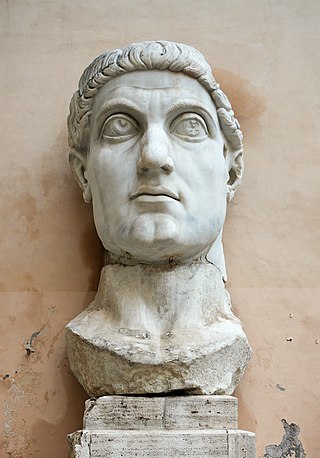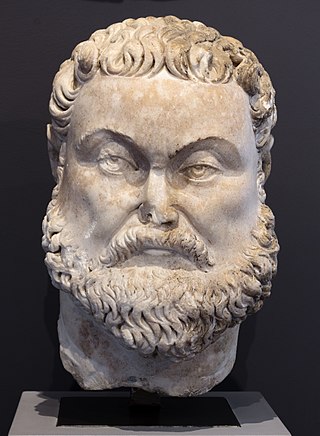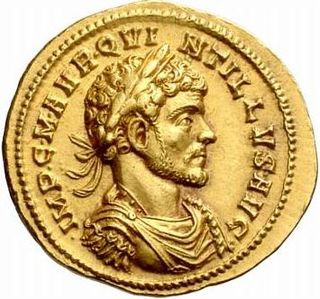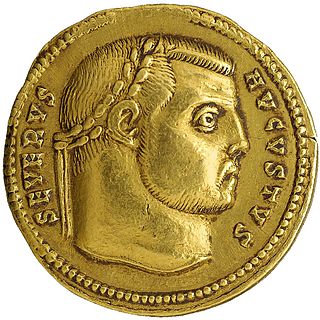
Constantine II was Roman emperor from 337 to 340. Son of Constantine the Great and co-emperor alongside his brothers, his attempt to exert his perceived rights of primogeniture led to his death in a failed invasion of Italy in 340.

Constantine I, also known as Constantine the Great, was a Roman emperor from AD 306 to 337 and the first Roman emperor to convert to Christianity. He played a pivotal role in elevating the status of Christianity in Rome, decriminalizing Christian practice and ceasing Christian persecution in a period referred to as the Constantinian shift. This initiated the cessation of the established ancient Roman religion. Constantine is also the originator of the religiopolitical ideology known as Constantinianism, which epitomizes the unity of church and state, as opposed to separation of church and state. He founded the city of Constantinople and made it the capital of the Empire, which remained so for over a millenium.
The 320s decade ran from January 1, 320, to December 31, 329.

Year 326 (CCCXXVI) was a common year starting on Saturday of the Julian calendar. At the time, it was known as the Year of the Consulship of Constantinus and Constantinus. The denomination 326 for this year has been used since the early medieval period, when the Anno Domini calendar era became the prevalent method in Europe for naming years.

Flavius Valerius Constantius, also called Constantius I, was a Roman emperor from 305 to 306. He was one of the four original members of the Tetrarchy established by Diocletian, first serving as caesar from 293 to 305 and then ruling as augustus until his death. Constantius was also father of Constantine the Great, the first Christian emperor of Rome. The nickname "Chlorus" was first popularized by Byzantine-era historians and not used during the emperor's lifetime.

Galerius Valerius Maximianus was Roman emperor from 305 to 311. During his reign he campaigned, aided by Diocletian, against the Sasanian Empire, sacking their capital Ctesiphon in 299. He also campaigned across the Danube against the Carpi, defeating them in 297 and 300. Although he was a staunch opponent of Christianity, Galerius ended the Diocletianic Persecution when he issued the Edict of Toleration in Serdica (Sofia) in 311.

Maximian, nicknamed Herculius, was Roman emperor from 286 to 305. He was Caesar from 285 to 286, then Augustus from 286 to 305. He shared the latter title with his co-emperor and superior, Diocletian, whose political brain complemented Maximian's military brawn. Maximian established his residence at Trier but spent most of his time on campaign. In late 285, he suppressed rebels in Gaul known as the Bagaudae. From 285 to 288, he fought against Germanic tribes along the Rhine frontier. Together with Diocletian, he launched a scorched earth campaign deep into Alamannic territory in 288, refortifying the frontier.

Flavia Julia Helena, also known as Helena of Constantinople and in Christianity as Saint Helena, was an Augusta of the Roman Empire and mother of Emperor Constantine the Great. She was born in the lower classes traditionally in the Greek city of Drepanon, Bithynia, in Asia Minor, which was renamed Helenopolis in her honor, although several locations have been proposed for her birthplace and origin.

Marcus Aurelius Claudius Quintillus was a short-lived Roman emperor. He was a brother of Emperor Claudius Gothicus, whom he succeeded after Claudius' death in 270. Quintillus' claim to be emperor was challenged by Aurelian, who was proclaimed emperor by the legions he commanded. Quintillus' reign only lasted a few weeks. Different sources report his cause of death as murder by his own soldiers, in battle with Aurelian, or by suicide.

Flavius Valerius Severus, also called Severus II, was a Roman emperor from 306 to 307, and a member of the Tetrarchy. He shared control of the western half of the empire with Constantine I, but spent most of his short reign in a civil war against the usurper Maxentius, who later killed him and took over Italy.

Flavius Julius Crispus was the eldest son of the Roman emperor Constantine I, as well as his junior colleague (caesar) from March 317 until his execution by his father in 326. The grandson of the augustus Constantius I, Crispus was the elder half-brother of the future augustus Constantine II and became co-caesar with him and with his cousin Licinius II at Serdica, part of the settlement ending the Cibalensean War between Constantine and his father's rival Licinius I. Crispus ruled from Augusta Treverorum (Trier) in Roman Gaul between 318 and 323 and defeated the navy of Licinius I at the Battle of the Hellespont in 324, which with the land Battle of Chrysopolis won by Constantine forced the resignation of Licinius and his son, leaving Constantine the sole augustus and the Constantinian dynasty in control of the entire empire. It is unclear what the legal status of the relationship Crispus's mother Minervina had with Constantine was; Crispus may have been an illegitimate son.

Flavia Maximiana Theodora was a Roman empress as the wife of Constantius Chlorus.

Priestess of Avalon is a 2000 novel by American writer Marion Zimmer Bradley, completed posthumously by Diana L. Paxson. It follows detailing the life of Helena, first wife of Western Roman Emperor Constantius Chlorus and mother of Constantine.

Minervina was either the first wife or a concubine of Constantine I, and the mother of his eldest son Crispus.

The Constantinian dynasty is an informal name for the ruling family of the Roman Empire from Constantius Chlorus to the death of Julian in 363. It is named after its most famous member, Constantine the Great, who became the sole ruler of the empire in 324. The dynasty is also called Neo-Flavian because every Constantinian emperor bore the name Flavius, similarly to the rulers of the first Flavian dynasty in the 1st century.

Licinius II, also called Licinius Junior or Licinius Caesar, was the son of the Roman emperor Licinius I. He held the imperial rank of caesar between March 317 and September 324, while his father was augustus, and he was twice Roman consul. After losing a civil war, his father lost power and both he and Licinius Junior were eventually put to death.

The civil wars of the Tetrarchy were a series of conflicts between the co-emperors of the Roman Empire, starting from 306 AD with the usurpation of Maxentius and the defeat of Severus to the defeat of Licinius at the hands of Constantine I in 324 AD.

The German and Sarmatian campaigns of Constantine were fought by the Roman Emperor Constantine I against the neighbouring Germanic peoples, including the Franks, Alemanni and Goths, as well as the Sarmatian Iazyges, along the whole Roman northern defensive system to protect the empire's borders, between 306 and 336.

The Conference of Carnuntum was a military conference held on 11 November 308 in the city of Carnuntum, which at the time was located in the Roman province of Pannonia Prima. It was convened by the Eastern augustus (emperor) Galerius as a way to settle the dispute over the title of augustus in the West, and consequently, to cease the ongoing conflicts started the previous year when he, and before that Severus II, attempted to recover Italy from the usurpers Maxentius and Maximian. Present at the conference were the retired Diocletian, and his former colleague, Maximian.
Claudia was the purported mother of Roman emperor Constantius Chlorus according to ancient sources. These sources claim her to be a relative of Roman emperors Claudius Gothicus and Quintillus, a claim modern historians tend to view with suspicion.



















